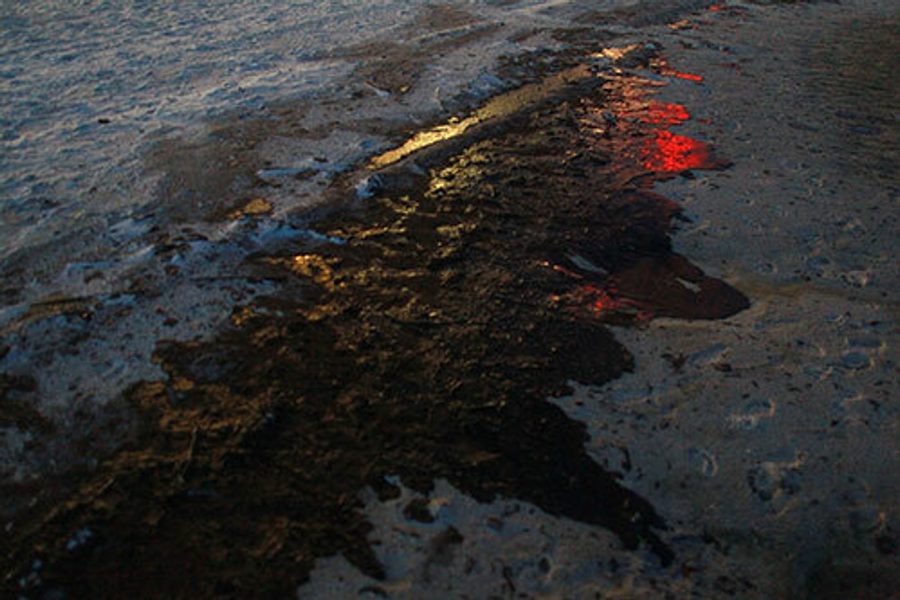
BP released its internal report on the Deepwater Horizon oil rig disaster that killed 11 workers and spilled millions of gallons of oil into the Gulf of Mexico on Wednesday.
The investigators concluded that no single catastrophic failure caused the demise of the Deepwater Horizon. Rather, BP’s report paints a picture of a rig that was so thoroughly defective that virtually every component of a multi-layered safety system failed at the critical moment. The authors of the report are so focused on blaming subcontractors for specific errors that they don’t seem to realize what a damning picture they’re painting of the entire operation. BP was not running a tight ship.
The worst oil spill in U.S. history started with what BP calls a “well integrity failure.” The cement plug that was supposed to seal off the well didn’t actually seal. The leak allowed gas to shoot up the riser pipe and flood the rig.
The report makes a pretty good case for blaming subcontractor Halliburton for pouring a shoddy plug and failing to test it. Halliburton was in charge of formulating the cement, pouring it, and testing the cement itself to make sure it set up properly. After the accident, BP went to great lengths to expose how poorly Halliburton mixed the cement. The report notes that Halliburton failed to perform key tests and suggests that Halliburton employees may have falsified the parts of the paper trail that does exist. If only BP had paid such close attention to Halliburton’s work before the disaster.
Before the accident, the crew had tested the plug to see if it would hold. The results of the negative-pressure test were strikingly abnormal and everyone knew it. The report concedes that, in retrospect, the test showed that that well wasn’t sealed. According to the report, BP well site leaders and Transocean rig crew “misinterpreted” the results of the test and concluded that the well was sealed.
The report implies that interpreting a fail as a pass was an understandable mistake because there wasn’t a lot of guidance available on how to interpret these tests. Allegedly, the Minerals Management Service (MMS) doesn’t specify what constitutes a minimum standard or a “pass” in a negative-pressure test. The report also claims that investigators were unable to find any industry standards for assessing a negative-pressure test either. Lax federal standards are no suprise, especially where MMS is concerned, but it is hard to believe that no industry standards exist for interpreting negative-pressure tests. Capping wells is a pretty routine operation in the industry.
On the day of the accident, the crew didn’t notice that the gas was escaping until it had already risen beyond the blowout preventer, which was designed to clamp down on the riser and pinch off a leak if the crew lost control of the well.
It turned out to be a moot point because the blowout preventer didn’t work anyway. It was later discovered that one of the backup systems for activating the blowout preventor had a dead battery, the other had a broken valve. BP would like us to assume that the fault lies with Transocean, the owner and operator of the rig, for failing to maintain the blowout preventer.
The rig was equipped with ventilation and fire control systems in place to prevent gas from spreading through the rig, but those didn’t work either.
BP’s contractors probably did some shoddy work, and in retrospect BP doesn’t seem to have been paying very close attention.
A September investigation by the Times Picayune newspaper gives a very different perspective on the series of mishaps that led up to the accident.
The Picayune investigation found that BP engineers were running the Deepwater Horizon in a hurry and on the cheap. They made a series of time-saving and cost-cutting decisions that left the rig vulnerable to a catastrophic failure – such as choosing to use a single long tube instead of a more expensive “tie back” setup. Independent engineers told the Picayune that the tie back setup is better because it creates an additional barrier to natural gas leaks. The Picayune cites a BP document saying that tie back was BP’s preferred option, but that it would have cost an extra $10 million. The Deepwater Horizon project was already millions of dollars over budget.
BP can quibble over who should have checked up on which test results, but the fact remains that BP was ultimately responsible for a string of bad management decisions that ushered in the disaster.







